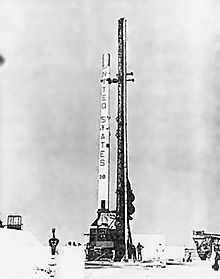 | |
| Function | Expendable launch system Sounding rocket |
|---|---|
| Manufacturer | Vought |
| Country of origin | United States |
| Size | |
| Height | 24 metres (79 ft) |
| Diameter | 1.02 metres (3 ft 4 in) |
| Mass | 16,874 kilograms (37,201 lb) |
| Stages | Four |
| Capacity | |
| Payload to LEO | |
| Mass | 30 kilograms (66 lb) |
| Associated rockets | |
| Family | Scout |
| Launch history | |
| Status | Retired |
| Launch sites | Canaveral LC-18B |
| Total launches | 3 |
| Success(es) | 2 |
| Failure(s) | 1 |
| First flight | 1961-03-03 |
| Last flight | 1961-11-01 |
| First stage – Algol 1B | |
| Powered by | 1 solid |
| Maximum thrust | 471 kilonewtons (106,000 lbf) |
| Specific impulse | 236 sec |
| Burn time | 40 seconds |
| Propellant | Solid |
| Second stage – Castor 1A | |
| Powered by | 1 solid |
| Maximum thrust | 286 kilonewtons (64,000 lbf) |
| Specific impulse | 247 sec |
| Burn time | 27 seconds |
| Propellant | Solid |
| Third stage – Antares 1A | |
| Powered by | 1 X-254 |
| Maximum thrust | 60 kilonewtons (13,000 lbf) |
| Specific impulse | 256 sec |
| Burn time | 39 seconds |
| Propellant | Solid |
| Fourth stage – Altair 1A | |
| Powered by | 1 X-248A |
| Maximum thrust | 14 kilonewtons (3,100 lbf) |
| Specific impulse | 255 sec |
| Burn time | 40 seconds |
| Propellant | Solid |
The RM-90 Blue Scout II was an American sounding rocket and expendable launch system which was flown three times during 1961. It was used for two HETS test flights, and the launch of the Mercury-Scout 1 satellite for NASA. It was a member of the Scout family of rockets.
The Blue Scout II was a military version of the NASA-operated Scout X-1.
